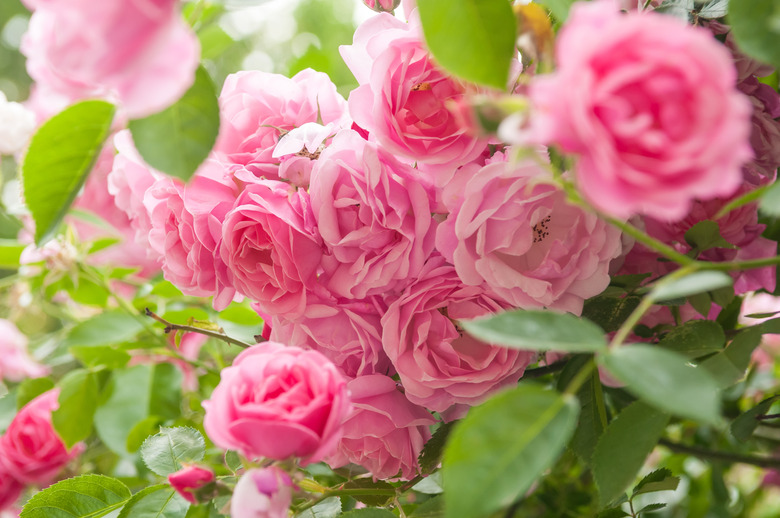How To Make A Natural Fungicide For Rose Bushes
Roses (Rosa spp.) make beautiful and fragrant additions to a garden, but sometimes prove difficult to grow. Many varieties are susceptible to fungal diseases, which can make it a challenge to keep them looking their best. This is particularly true for organic gardeners, who can't just pop to the hardware store for a quick fix when fighting garden diseases and pests. The good news is that a homemade baking soda-based mixture makes a natural fungicide for rosebushes.
What You're Up Against
Roses can suffer from a wide variety of fungal diseases, but black spot fungus and powdery mildew are the most common in the United States. Downy mildew and botrytis blight are also fairly common.
As the name implies, black spot fungus on the leaves of your plant creates black spots with yellow borders. The disease can eventually cause leaf drop. Without adequate leaves for robust photosynthesis, the rosebush will produce fewer blooms and lose its overall vigor.
Like black spot, powdery mildew is easy to identify. It makes the entire plant appear dusted with flour. Botrytis blight is a bit more particular, tending to attack flowers and buds rather than the entire plant and coating its victims with a grayish-brown fuzz. Although it usually starts with the roses themselves, botrytis travels down the stems of the plant if left untreated.
Often misidentified as black spot fungus, downy mildew creates black, red or purple spots on rosebush leaves and works from the top of the plant down, while black spot moves up from the bottom. Black spot lesions can appear anywhere on a leaf, but patches of downy mildew stay between leaf veins.
Preventing the Problem
An ounce of prevention really is worth a pound of cure — particularly in an organic garden where harsh chemical fungicides are banned. Preventing fungal disease starts with disease-resistant cultivars: 'Eiffel Tower,' 'Matterhorn,' 'Carefree Wonder,' 'Saratoga' and 'Pink Parfait' all resist both powdery mildew and black spot disease.
It's also important to keep your garden clean. Prune away any dead or diseased canes on your roses as soon as you see them. Rake up fallen leaves and rose petals frequently. If you've had diseased leaves or flowers fall onto your mulch, rake it up at the end of the season and replace it with fresh mulch in the spring.
Note that, with the exception of powdery mildew, most fungi need a lot of water and moisture to thrive, so do your best to deprive them of this favorable environment. Use soaker hoses to water your plants rather than watering from above, and, after a rain shower, stay away from your roses until they dry. Plant multiple rosebushes 3 to 4 feet apart so that air can easily circulate around them.
Natural Fungicide Recipe
Sometimes solutions to plant problems are simple. For example, you can often cure powdery mildew with nothing more than water. Spray the leaves of the plant with ice-cold water first thing in the morning so they have all day to dry. A few days of this is often enough to cure powdery mildew.
If this doesn't work — or if you're dealing with a different problem — you can turn to home remedies. Gardeners admittedly share some crazy remedies for garden problems, but there's some scientific evidence backing the use of baking soda as a fungicide when it's mixed with an oil. The Clemson Cooperative Extension recommends a baking soda and oil mixture for natural fungal control.
To make a natural fungicide for your roses, Clemson recommends adding 3 tablespoons baking soda and 3 tablespoons horticultural oil to 1 gallon of water. It's important to note that horticultural oil is not the same as cooking oil. Mix the ingredients well and then transfer them to a spray bottle. Spray the leaves of your roses liberally with the mixture, remembering to spray the underside of the leaves as well. The plant should be dripping wet when you're done.
This concoction works well when applied weekly to plants as a fungal prevention. It also cures some fungal diseases, including powdery mildew. For continued protection, spray your plant with this mixture about once a week.
